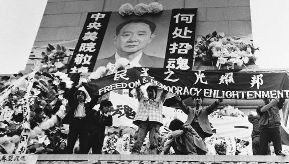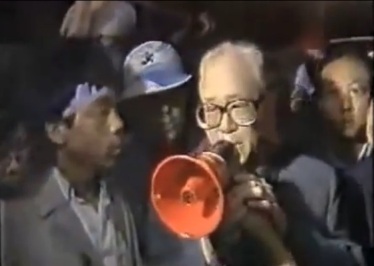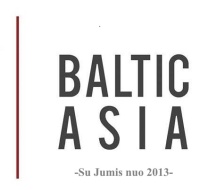Tiananmen Square Protests
Dark night falls on the huge square full of flames and smoke, disguising bodies scattered here and there, with people shouting loudly in Mandarin, people wailing, surrounded by ear-splitting sound signals of ambulance and police cars.
It might look like a war, only the sides of combatants would be too unequal and the end too sudden, but this scene merely marks the end of one of the biggest peaceful pro-democracy demonstrations that took place in China 25 years ago. Tiananmen square protests, sometimes called Beijing/Chinese Spring, lasted a bit more than 1 month and 2 weeks and were severely suppressed not less abruptly than it had sparked–in one night.
Today Tiananmen, the central square of Beijing, as well as the largest one in the world, stands still, as the picture of Mao Zedong hangs over the gate to the Forbidden City, as if observing fellow Chinese and occasional flocks of tourists. Its atmosphere is totally different from the one 25 years ago. As time flows by, fewer and fewer people in China, let alone outside, remember this anniversary. Hence this article is a symbolic tribute to one of the biggest pro-democracy demonstrations that took place in the spring of 1989 in China, with a hope that people who participated, with idealism in their hearts, not guns in their arms, will always be remembered, and those who live in freedom will truly cherish it.
Gulps of Freedom
The year 1989 was marked with hope in most of the Soviet world, resulting in revolutions in that or the following year. China was not an exception. The year 1978 foresaw a significant economic liberalization, a project which was called “Socialism with Chinese characteristics”, headed by Deng Xiaoping, the Vice-Premier reformist and de facto “paramount leader” who would later be a key person to suppress the Tiananmen square protests. However, economic and political reforms were not easy to make in a country as big as the PRC, and corruption became widely seen. Witnessing this, anger was starting to grow silently among the Chinese people, but significant unrests were avoided after the one in 1976. It was not until 1989 that the massive nation-wide protests burst out, bringing the country on the verge of a revolution (as it happened in the East Bloc in Europe), protests which might have changed Chinese political course dramatically.
A Major Pro-Democracy Demonstration
When the General Secretary Hu Yaobang refused to take a hard-line crackdown on the demonstrations of 1986, he was denounced by Conservative Communists and was forced to resign in 1987, gaining popularity among progressives, intellectuals and students.

Tiananmen Square Protests: Funeral of a reformist Hu Yaobang.
Two years later, Hu Yaobang passed away creating an impetus for students to gather in big numbers, making eulogies and calling for a rehabilitation of Hu’s legacy. This was the onset of what would later be called Tiananmen square protests. At first, a small number of people spontaneously gathered in front of the Monument to the People’s Heroes, located in the Square, on April 15th, the day when Hu Yaobang died. Later they were joined by many students from Peking University and Tsinghua University.
Two days later, some 500 students from China University of Political Science and Law made a large wreath to commemorate Hu in The Great Hall of the People near the Tiananmen Square, and gave public orations about social problems until police intervened. The very same night, more than 3000 students marched towards the Tiananmen Square, joining forces with those who had gathered in the square. The gathering gradually evolved into a protest, as students drafted Seven Demands for the Government, demanding freedom of speech, the increase of funding for education, more publicity on the Government officials and the affirmation of Hu Yaobang’s views, among other things. On April 18, several thousand students tried to hand the list directly to the Communist party leadership, but were denied by the police.
It was not long until the biggest square became crowded with people of various cultural backgrounds, from students to workers. Some students occupied the square by erecting shrines, tents, and refusing to leave them until their demands were fulfilled, singing songs. On the eve of Hu Yaobang’s state funeral, Tiananmen Square witnessed some 100,000 students marching, ignoring the will of Beijing Municipal authorities. The funeral itself took place inside the Great Hall and seemed rushed as it lasted only 40 minutes, but emotions ran really high in the Square. The funeral was attended by the leadership; eulogy was made by the General Secretary Zhao Ziyang and was broadcasted live to the students. 3 students attempted to present a petition, demanding to see Premier Li Peng, having knelt on the steps of the Great Hall to present a petition, but were denied, thus leaving students very disappointed. The wave of protests was spreading quickly into other major cities of China, though its nature was not that peaceful. For example, in Changsha or Xi’an serious rioting broke out.
On April 23, students formed The Union, also known as Student’s Parliament: an independent organization which called for a general class boycott at all Beijing universities. It was led by a student Zhou Yongjun, with Wang Dan and Wu’erkaixi also emerging as leaders.
On April 27, The Union organized a huge demonstration. Some 50,000–100,000 students marched through the streets of Beijing to Tiananmen Square, breaking through the lines set up by the police, and receiving widespread public support along the way, particularly from factory workers. This made a certain turning point in the demonstrations, and meeting student representatives by the government officials became inescapable. April 4 witnessed yet another huge student rally as the date coincided with the 70th anniversary of the historical May Fourth Movement.
Different Responses by the Chinese Communist Party

Tiananmen Square Protests: General Secretary of the Communist Party of China (CCP) Zhao Ziyang addresses the students
Premier Li Peng backed the idea of taking serious actions against protestors immediately, but General Secretary Zhao Ziyang supported the open dialogue with students. Not only Premier and the General Secretary, but other members inside the ruling Communist Party also became divided regarding the issue. In the morning of May 19, Zhao Ziyang and Wen Jiabao emerged in Tiananmen, delivering an emotional speech (which proved to be his last public appearance) with a bullhorn in front of the crowd, asking to terminate the hunger strike. Zhao viewed Tiananmen square protests as “legitimate” and “patriotic in nature” and would go far enough expressing his support for more transparency and democracy, hence confronting Conservatives in the party. However, not all participants in Tiananmen square protests were satisfied with a formal dialogue with the Government, as they believed it was a simple trick, so student leaders such as Wang Dan and Wu’erkaixi began mobilizing students for a hunger strike, a move which initially drew much support from the general public, particularly factory workers, and would be later considered a wrong move by one of the student’s leaders Li Lu nevertheless.
Written by: Audrius Sabūnas
Edited by: Monika Dvirnaitė
Additional information on Tiananmen Square Protests
References (Tiananmen Square Protests):
- Moving the Mountain (1994), documentary, directed by Michael Apted.
- Recollecting Tiananmen. Special Radio Free Asia slide show reports, including songs
Images (Tiananmen Square Protests):
